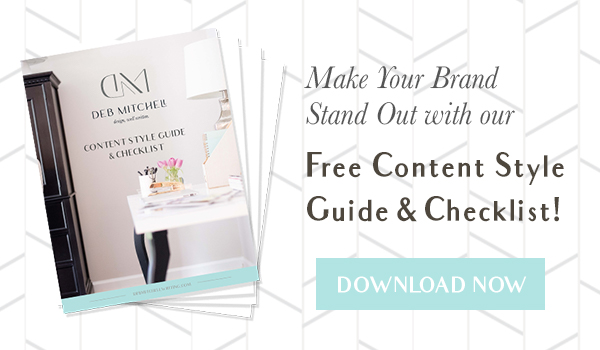When one of my sons was in kindergarten, he came home telling me a story about a girl in his class. As he was describing the girl’s clothing, he referred to her as wearing a “topless dress”. Since I knew topless dresses didn’t exactly meet the dress code standard at his school, I was curious to figure out what he actually meant by this!
As I got him to explain more, I figured out that the girl was actually wearing a skirt, but his 5 year old mind had adorably and hilariously decided it would best be described as a “topless dress”.
While a skirt technically IS a topless dress, I had to teach him that the correct word we use for that item of clothing is “skirt”.
The language that we use is super important, and as cute as his mistake was, I didn’t want him setting off any alarm bells by incorrectly describing his classmate’s clothing!
As a copywriter for interior designers, I know that the first step toward connecting with your ideal clients is to speak their language in your online presence. Because connections are formed between people who feel like they’re on the same page–like they’re “speaking the same language.” And in the case of your clients, they first need to be able to even find you online and using the same language they’re using to search for interior designers is critical.
Metaphorically speaking, if they’re searching for a skirt, but you’re calling it a “topless dress” on your website, they won’t be able to find you!
For example, when I first started my writing business, I must have tried every possible iteration for ‘writer’ on my website (‘freelance writer,’ ‘website writer,’ ‘interior design writer,’ ‘marketing writer’). Even though I knew I was a copywriter, it wasn’t until I learned that most website designers direct their clients to hire a copywriter that I realized my people were actually looking for me using that terminology. Making the switch to describe myself as a copywriter and providing copywriting services for interior designers was a game changer for attracting my ideal clients!
If you’re not using the keywords on your website that they’re typing into their search engine, then your site won’t even pull up for them, and that initial connection won’t happen!
Once you nail down the right keywords and they DO find you, speaking your ideal client’s language in your website copy will also build a deeper connection to you.
You know that amazing feeling you get when you finally find a trusted professional that can help you? It’s like a doctor who listens to what you’re experiencing, adds their experienced take on the matter, and presents you with solutions to address the problem. You feel so much relief and comfort knowing that you’re in the good hands of an expert who hears you and who can guide you.
That’s exactly how you want your ideal clients to feel while reading your brand messaging. And in order to spark that deeper connection, your marketing materials need to be using language that resonates with them. You need to talk like you’re already listening to them.
Now, to be clear, I’m not just talking about tone or brand personality here. I’m also talking about your choice of words!
When you’re trying to grow your business by attracting the attention of your dream clients, you can’t risk miscommunication. Connecting through language is essential to getting you in the room with these people. And getting in the room with the right people is how you create a business that you love.

You have to translate “business owner language” into your ideal client’s language
It’s important to stay true to the brand personality that feels authentic and original to you. You want to speak in your own voice, and write the way you speak. You don’t want to sound like a copycat version of someone else!
But the words you use to talk about your business and describe your aesthetic are usually different from how your clients think and speak. So while you want to choose website messaging that beautifully captures who you are, it must also be wording that makes sense to your ideal clients.
This means that for your messaging to be successful, it’s critical that you find a way to translate the language you use as a business owner into the language of your ideal clients.
I know it sounds complicated, and quite frankly, it is. Which is why you need someone with marketing expertise who’s fluent in both languages, and can effectively do the translating for you.
Empathy is the key to learning your ideal clients’ language
So how exactly do you figure out your ideal client’s language? My best piece of advice is to think of empathy as your secret weapon!
Use empathy to put yourself in your client’s shoes, and really think about where they’re coming from. You want to consider things like:
- What are their worries, fears, likes, and dislikes when it comes to hiring an interior designer?
- What do they know and what don’t they know about working with a designer?
- Which of your brand’s values can you highlight that actually matter to them, as well?
- Is there anything specific or niche about the home market they live in?
Speaking to all of this in your messaging will create major points of connection by helping your prospects feel seen and heard by you–especially if you express it all using words they can readily understand.
When I’m creating messaging for interior designers, I use empathy LIKE CRAZY! Empathy allows me to pick up on important nuances other writers may miss. I’m using empathy to listen for what my clients care about, how they run their business, and what will make them happy and fulfilled. And at the same time, I’m also using empathy to put myself in their ideal client’s shoes, and think about what type of language THEY need to hear. It’s an empathy-fest around here 24/7!
When you work with me, I translate your design business owner’s language into the language of your ideal client. I work to preserve who you are and what you care about but I also troubleshoot the words you love from all angles to make sure we get it right. Because I know that sometimes a turn of phrase that sounds good in your mind, may land differently with your client and cause problems in your working relationship. And that’s definitely not what we want!
For example, here are just a few common language mistakes I see interior designers make:
- “We’re a collaborative design firm” – I see this one all the time! As a designer you might say this to mean you work well with other industry pros, like contractors, architects, and builders OR that you have a team and you all work together on behalf of your clients. You may even mean that you work closely with your clients upfront as you get to know them and their tastes and lifestyle needs. That’s all well and good but prospects can interpret this to mean you welcome collaborating on the entire design with THEM! So if you keep attracting clients who micromanage you, or who send you pics every weekend of the ‘amazing piece’ they just found for the design, you may want to delete this word from your website and vocabulary!
- “We work with your project, no matter how small” – Another common one I see! Unless you truly mean that you’re happy to put everything else aside to help someone pick between two potential backsplash tiles for $50/hour, you really shouldn’t say this. Prospects don’t know why it’s important to some designers to adhere to minimums (let alone that a ‘small’ project to you actually means a $20,000 powder room).
- “We make sure to work within your budget” – While I get that you may say this to mean you’ll be a good steward of your client’s investment, there’s just way too much room for interpretation here. Prospects can (and do!) think this means you’ll be able to make any amount they bring to the project work for the scope of their project. If you’ve ever been hit with a prospect who wants you to furnish their entire living room for $5,000, this could be the reason why (also, HGTV, but that’s another topic altogether!).
These examples may not be as off the mark as my kindergartener’s “topless dress” verbiage, but still! Really thinking about how the words you put out there will be received by your ideal prospects can truly make all the difference in who you attract.
Pay attention to the language cues your current clients give you
Getting to know your ideal clients on a deeper level is a building process that can take time. But with each client project comes more experience to draw from, and you’ll begin to understand these people–and the language they use–more and more.
You can start learning their language by taking notes on who they are and what they say.
- Pay attention to how they respond to you in real conversation. Think about how your clients react to the things you say. What makes them lean in and excitedly say, “Oh yeah, I get it!!” vs. what tends to leave them with a confused look on their face? Pull language from these points of connection to use in your brand messaging, and stay away from the wording that tends to cause a visible disconnect.
- Pay attention to the off-the-cuff words they use to describe your work. (Particularly in casual modes of communication.) Look for these clues in their texts and emails to you, instead of their official testimonial. For example, if they send you a text exclaiming, “I just saw the new living room. I love how light and airy it feels!” Boom – now you’ve got some great descriptive words to describe your aesthetic! You know that “light and airy” could really resonate with new ideal prospects, because this is the type of language your current clients are using to describe your work.
- Pay attention to what they care about. Are your ideal clients people who love to go to the classical symphony, or are trendy music festivals more their vibe? Are they seasoned art collectors, or are you introducing them to original art for the very first time? You’ll need to speak very differently to these distinct groups of people.
As an interior designer, if you aren’t aware of the importance of thinking through your ideal client’s lens, you may end up trying to write your copy with words from your own head. Or you’ll end up cherry-picking phrases from other people’s messaging, which won’t sound truly authentic to you. Neither of which are speaking in a way that resonates with your ideal client!
However, when you translate your messaging into language your ideal clients understand, you’ll start attracting more of those clients. Recently, a designer I’m working with emailed me in the middle of our website copy project to say she was already noticing a huge change in more aligned inquiries, just based on the first pieces of messaging we started putting out there! I’m telling you, this stuff really works!!
So my question for you is – Are you absolutely sure you’re speaking the language of your ideal client on your website and messaging? If not, I can help!If it sounds amazing to have someone come in who’s fluent in design business language and the language of your ideal client, contact me here and let’s talk about it!


 As business owners, you and I both know that it sometimes feels like you have to pay big bucks if you’re ever going to get yourself in front of your ideal clients.
As business owners, you and I both know that it sometimes feels like you have to pay big bucks if you’re ever going to get yourself in front of your ideal clients.

 Designers ask me all the time if they “really need to blog.” And I totally get it – who wants to add something like that to their to-do list?!
Designers ask me all the time if they “really need to blog.” And I totally get it – who wants to add something like that to their to-do list?! 





